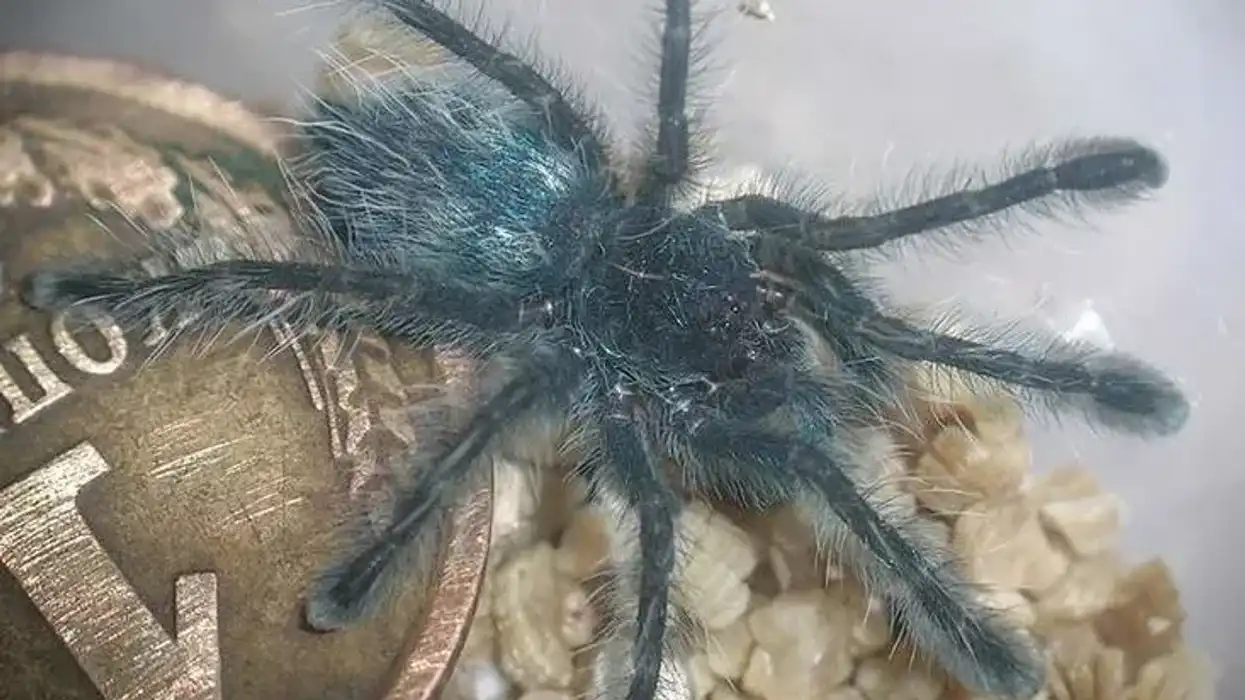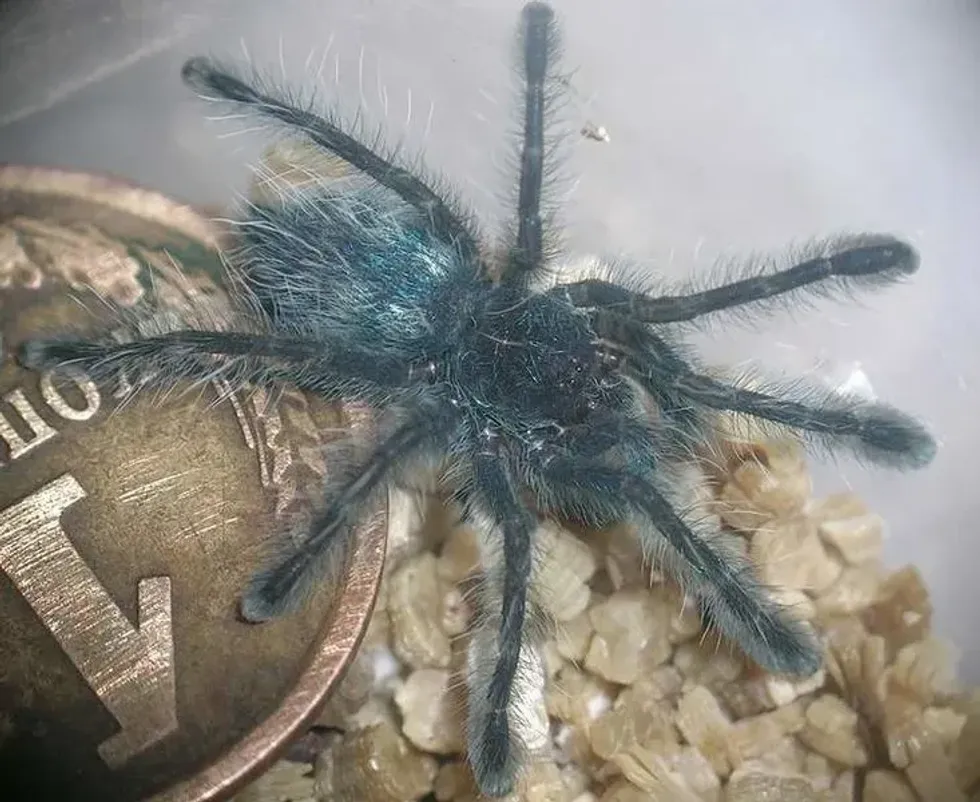Caribena versicolor comes from Martinique in the Caribbean Sea and was previously classified in the genus Avicularia. The Antilles pinktoe tarantula is arboreal by its behavior, which means it lives in trees.
They construct magnificent funnel webs on trees where these species are mostly found. The blue tinge of the tiny, brown agarwood overgrown with spiderlings of Caribena versicolor is quite brilliant. The abdomen is black with a dark tree trunk design.
As they mature, the blue tints will fade and the carapace will become green; the abdomen will turn red while the legs become pink. The tarsi are also pink with purple color hair.
The majority of male Antilles pinktoe tarantulas are more vibrant and colorful in comparison to females. Males and females grow at different rates, with males remaining somewhat shorter than females even when adjusted for size.
This is a medium-sized tarantula species that grow to be around 4.5–6 in (11–15 cm) in length. In 1892, the Antilles pinktoe tarantula, also known as Avicularia versicolor, was classified by Eugène Simon, whereas in 1837, Mygale versicolor has been identified by Charles Athanase Walckenaer.
It was later in 2017 when the species was moved to the new genus Caribena. Martinique, which is located south of South America near the Caribbean is the native place to these species.
It is also found in Brazil and near areas. The coloration of these tree-dwelling spiders is bright, and they do not have any particular color enclosure to keep their colors consistent.
The Antilles pinktoe tarantula, Caribena versicolor, eats live crickets, grasshoppers, and Dubia roaches as its main diet. Caribena versicolor are very docile by their nature and seldom bite, but they dislike being taken care of.
Versicolor Spider Interesting Facts
What type of animal is a versicolor spider?
The Antilles pinktoe tarantula, Caribena versicolor, is also known by other names the Martinique pinktoe or the Martinique red tree spider, is a popular pet among spider species because they have docile nature as well as distinctive coloration.
What class of animal does a versicolor spider belong to?
The Antilles pinktoe tarantula, known by the scientific name Caribena versicolor, belongs to the genus Caribena. They are from the family Theraphosidae and the class of Arachnida.
How many versicolor spiders are there in the world?
The exact number of Antilles pinktoe tarantulas, Caribena versicolor, is unknown and is not estimated at a global level.
Where does a versicolor spider live?
Caribena versicolor is a spider species that is found in South America. They are found in enclosures and dark areas. The Lesser Antilles, Martinique, and the Caribbean are also places where they could be found.
What is a versicolor spider's habitat?
In these southern regions of the United States, the climate generally remains warm most of the year. In mountainous areas, they can be found under logs or rocks under a canopy of trees.
On coastal plains, they dwell among shrubs and bushes near the beach. They need humidity, but high humidity would not be an ideal environment for them. They even require proper ventilation.
Who do versicolor spiders live with?
It is unknown who Caribena versicolor lives with, but this species is known to lay 50–200 eggs during the breeding season.
How long does a versicolor spider live?
The Antilles pinktoe tarantula, Caribena versicolor, lives up to the age of 12 years. In comparison to males, females live longer lives. The male Antilles pinktoe tarantula lives only three to five years, while the female Antilles pinktoe tarantula lives for 12 years.
How do they reproduce?
The male Antilles pinktoe tree spiders from the genus Caribena have hooks on their first pair of legs. During courtship or mating, these hooks grab hold of the female's fangs for reproduction.
After a male has released a sperm web, the male comes close to the female's enclosure. If you own a pet, then after breeding, the female should be fed more and lay around 50-200 eggs, which takes almost a period of four weeks.
What is their conservation status?
The conservation status of the Antilles pinktoe tarantula, Caribena versicolor, is unknown because of fewer scientific facts. They are generally seen around in the wood enclosure to protect themselves and catch their prey in the web. A spider, in general, takes 30-60 minutes more or less to form a web.
Versicolor Spider Fun Facts
What do versicolor spiders look like?
The coloration of these tree-dwelling spiders is bright, and they do not have any particular color enclosure to keep their colors consistent. The Antilles pinktoe tarantula's coloration can be altered from their blue and rose red to rustic patches. Some iridescent greens have purple touches on their carapace and abdomen sides.
They also might have bright red hair on their stripes. There is a bald-looking area near the lower abdomen. This is not from rubbing; it's just a bald-like spot.
The carapace has two colors: iridescent jade green and bluish-green. It also has highlights of blue.
Just like a box of chocolates, you just never know what you’re getting. The length of a female Antilles pinktoe tarantula in the first year is approximately 2.5 in (6 cm). The average length of an adult female is 6 in (15 cm).
When the female hatches, the spiderlings are no more than 0.5 in (1 cm) in length. Males are smaller than females. They also molt their skin, and new skin is seen on their bodies.
How cute are they?
For those who are fond of spiders, the Antilles pinktoe tarantula, Caribena versicolor, might at first appear cute due to its abdomen coloration. Otherwise, the Antilles pinktoe tarantula is not cute at all and looks like a venomous species, although it is not very venomous.
How do they communicate?
The communication of the Antilles pinktoe tarantula, Caribena versicolor, is unknown. To catch their prey, they are seen weaving the web in the dark enclosure parts of the tree.
So, spinning a web could be one of the gestures these species use to communicate with each other. If you annoy them, then they might turn on you and bite you, leaving behind skin rashes.
How big is a versicolor spider?
The Antilles pinktoe tarantula is 4.5-6 in (11-15 cm) in length.
How fast can a versicolor spider run?
The adults spin webs to catch their prey at a good speed like other spiders in the dark enclosure of tree bark, but their locomotion speed is unknown.
How much does a versicolor spider weigh?
The weight of an Antilles pinktoe tarantula who lives in a humidity enclosure with ventilation is unknown.
What are the male and female names of the species?
The male and female of the species are known by their common names, male Antilles pinktoe tarantula and female Antilles pinktoe tarantula.
What would you call a baby versicolor spider?
The baby hatched out of eggs laid by the female during the breeding season is called a spiderling.
What do they eat?
The Antilles pinktoe tarantula, Caribena versicolor, eats live crickets, grasshoppers, and Dubia roaches as its main diet. So, it can be said that the Antilles pinktoe tarantula, Caribena versicolor, has an insectivorous diet while the small prey is required by the small juveniles or spiderlings, such as mealworm and crickets without a head.
Are they poisonous?
Caribena versicolor are very docile by their nature and seldom bite, but they dislike being taken care of. Although they may bite, it is not harmful and isn't any more painful than a typical bee sting.
Furthermore, the hairs on the body of the Caribena versicolor might be uncomfortable and may cause itching and redness locally. They have very mild venom due to which you might feel the stinging pain.
Would they make a good pet?
When keeping a tarantula as a pet, the arboreal species should be kept in an enclosure that simulates their natural habitat; this should contain plenty of height and branches for climbing onto the web, with good levels of humidity along with proper ventilation.
The diameter of the enclosure must also be large enough to allow the body of the tarantula to extend its legs fully without touching the sides.
High humidity or high temperature in an enclosed habitat would not be ideal for these creatures.
Did You Know...
If you want to handle sipiders, then Caribena versicolor would be an ideal choice for the beginner level as they are docile and have mild venom. However, they do not take pleasure in being handled.
All you need to do is to leave these spiders in their own conditions, whether they be males or females of the species.
The temperature and humidity level should also be taken care of as they matter the most for their growth. It is feasible for the Antilles pinktoe tarantula, Caribena versicolor, to lay between 50-200 eggs, which hatch into small juveniles, taking up to four weeks.
This is majorly affected by the time taken by females to carry their sacks of eggs along with them.
The versicolor spider is so named because the color of its abdomen changes as it grows from blue to a range of different colors such as pink, green, and orange. This ability to change color gives this spider its scientific name 'versicolor' which essentially means 'constantly changing'.
How long does it take a Caribbean versicolor to grow?
The Antilles pinktoe tarantula, Caribena versicolor, is a New World tarantula that is only found in the areas of the Caribbean, Martinique, and the Lesser Antilles. This is a medium-sized tarantula species that grow to be around 4.5–6 in (11–15 m) in length.
The lifespan of males is approximately three to five years, while females live up to 12 years and reach a substantial size.
Is versicolor tarantula arboreal?
Yes, the Antilles pinktoe tarantula, Caribena versicolor, is an arboreal tarantula species. It has often been reported anecdotally as an arboreal tarantula due to its behavior of hiding inside branches and logs with only its legs sticking out for the comfort of the body.









